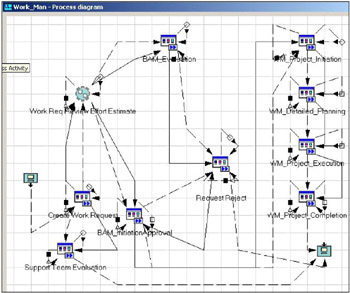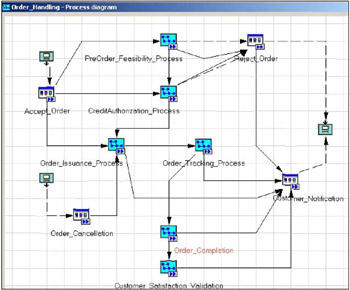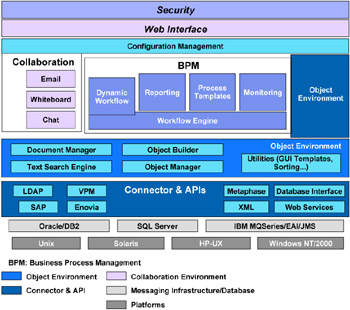5.4 Galaxia ePCM
|
| < Day Day Up > |
|
5.4 Galaxia ePCM
In the engineering domain, ePCM allows those who participate in the manufacturer's product change management process to work in concert to develop, deliver, and support best-in-class products. ePCM supports everything from simple document-based workflows to workflows with application-level integrations.
Galaxia provide solutions for
-
Engineering
-
Project and program management
-
Procurement and materials
-
Quality management processes
-
IT processes
ePCM supports everything from simple document-based workflows to workflows with application-level integrations.
Minimal training will enable IS/IT people to use the ePCM toolset to model new processes and manage them independently. In partnership with IBM, Galaxia also offers hosting solutions to augment existing IT infrastructures. In the engineering domain, ePCM allows those who participate in the manufacturer's product change management process to work in concert to develop, deliver, and support best-in-class products.
5.4.1 ePCM product overview
Business Process Management involves understanding the process, creating a process model, and integrating people and applications to provide a platform for the customer to optimize and improve its business processes.
ePCM is a process-centric EAI [30] framework that enables businesses to manage their existing and future business processes. ePCM integrates people and applications through a user-oriented workflow and application integration framework.

Figure 5-20: EAI framework
It spurs application integration using IBM's WBI [31] standards and products, and can enhance collaboration through workflows and collaborative tools like Lotus Instant Messaging and Team Workplace. [32] When integrated with WebSphere Portal, ePCM provides an on demand dynamic workplace for people to collaborate and participate in enterprise-wide business processes.
ePCM architecture follows the standard MVC [33] pattern and three-tier architecture, that separates presentation, business, and data access logic. The business logic is basically encapsulated in the workflow-based process model. Application integration is based on messaging and uses WebSphere MQ [34]as its backbone.
Some of the key features of ePCM include:
-
Process modeling—The typical process model has many activities and associated users. Access is controlled by role-based authorizations. A process can be modeled to spawn a sub process or trigger an external application. The activities modeled in the process can be manual or automatic, synchronous or asynchronous, and hence can trigger external applications. Users will be notified about work through email via a work item in their worklists. Processes can have any number of conditions or business rules attached, with any number of users and roles, parallel paths, loops, and nested loops.
-
Process and form templates—Processes are modeled as standard templates to reduce the build/deployment time of a process model. Use of templates to model and standard forms to view the application data helps business analysts and the IS/IT staff to easily configure a new process-centric application. With minimal training, users can deploy new business processes as well as create and set parameters for the forms required to view the application.
Standard templates modeled in ePCM include:
-
Engineering Change Management processes such as RFCs, [35] ECRs, [36] and ECOs [37]
-
Work Management and Task Allocation processes
-
Quality Management processes
-
Procurement and Materials
-
IT processes
Form templates support automatic ID creation, links to utilities such as Document Manager, support for features like WIP [38]notification, and reject loop support.
Worklist templates give detailed information regarding each work item to help users quickly identify the state of a work item.
Drill-down capabilities exist for detailed view or tracking of work item details.
-
5.4.2 Templates for engineering processes
Standard templates for Change Management processes like RFCs, ECRs, and ECOs enable manufacturers to have better control over their product design and to manage design changes.
These templates provide a fast track for implementing a customer-specific solution, leading to tighter cost controls and quality products.

Figure 5-21: Process templates for engineering
5.4.3 Templates for the Work Management and Task Allocation process
The Work Management and Task Allocation template helps managers efficiently track programs, projects, and tasks. This could require multiple levels of management approvals. Risk and Project Management from initialization to completion can be realized using this template. IT/IS managers can use it to manage their IT resources (support staff, project resources, etc.).

Figure 5-22: Work management template
5.4.4 Template for order processing
The Order Handling Process covers issuing and accepting orders. This includes sub-processes such as:
-
Pre-order feasibility studies
-
Credit verification and authorization
-
Order issuing and configuration
-
Order tracking and completion
-
Customer satisfaction validation to measure and benchmark expectations
This template helps companies manage customer orders and configuration requests efficiently.

Figure 5-23: Order Handling Process
ePCM can be used to model any enterprise business process and deployed in a matter of days. Modeling business processes can provide solutions for other business verticals (e.g., in the Financial, Health and Pharmaceutical, Energy, and Retail industries). Portal version of ePCM enhances use of existing infrastructure and unified access to various business processes/applications. For example, the above scenario shows a unified access through WebSphere Portal to engineering data using applications like ePCM and ENOVIA 3d com Navigator. ePCM leverages WebSphere Portal functionality such as:
-
User registration
-
User management
-
Authorization
-
Authentication
-
Single sign-on and security features enabling standard access to enterprise applications and content
-
Personalization
-
Integration with collaboration tools like Lotus Instant Messaging
5.4.5 Workflow federation
Business processes span multiple applications. Since any of these might possess workflows unique to their respective systems, there is a need for orchestrating these individual workflows to provide a seamless end-to-end solution. ePCM acts as an enterprise-wide federator of such workflows. Using the WebSphere Business Integration framework, ePCM federates other enterprise applications (e.g., ERP, PDM, and legacy applications).
Figure 5-11 on page 232 shows ePCM mapping against enterprise architecture specific to the Automotive and Aerospace Industries. ePCM can easily map to enterprise architecture in other industry verticals.
5.4.6 Other ePCM features
Object Manager
Since business objects usually have a definite lifecycle, they can be seen as "Evolving Business Objects." ePCM has an Object Manager to represent basic business objects such as RFCs, ECRs, or ECOs as well as any custom-built business object. Objects can be built, visualized, and searched using the ePCM Object Manager—which also provides support for inheritance and dependencies—and attached to individual process instances to enhance information.
Workflow monitoring and e-reporting
ePCM audits processes and activities through its Process Monitoring and e-Reporting capability. This monitor helps users attain a global view of the process. The e-Reporting feature queries audit trails to report statistics such as Process Cycle Time, Start Time, End Time, Work Time, and Wait Time of processes and activities. The reporting tool also includes such features as comparison between two process instances, charting and graphical representation of various statistics, Quick Search, and preferred search capabilities.
Document Manager
The Document Manager module helps implement the paperless office. It can be used to connect documents and other related files to a process instance while supporting multiple formats and managing different versions of file attachments. It also tracks the history of each attachment. External content management systems can be used to manage these various document versions through stored parameters. The Viewer Center provides 2D/3D visualization as well as manipulation and annotation of standard CAD formats.
EAI framework
The EAI platform uses a hub-and-spoke architecture for IBM products such as WebSphere Interchange Server [39] and WebSphere MQ. This integration uses the connector framework provided by WebSphere Business Integration as well as custom-built connectors. ePCM connects to ENOVIA VPM [40] using the Galaxia VPM Connector, to LCA, and to ERP systems.
| Note | In Figure 5-24, "VPM" refers to ENOVIA VPM. |
The Galaxia VPM Connector Controller translates workflow messages sent from ePCM into ENOVIA VPM commands (for example, to create an Action object). The Controller Agent reads the ENOVIA VPM commands and executes them. On completion of the Action flow, the status of the Action Object is set to completed. The Connector Agent then translates the ENOVIA VPM message to its corresponding Workflow message.
The Connector supports creation, modify, search, and promote commands from ePCM.
Following are some of the advantages that can be realized by using the ePCM VPM Connector:
-
Automatically updating legacy systems with engineering changes from your PDM systems
-
Ensuring that builds are updated to the most current revision
-
Preventing missed delivery commitments by enabling engineering and manufacturing departments to synchronize product data
-
Reducing time to market.
-
Receiving ECRs from the client's customer electronically and sharing information with other processes
Collaborative Suite
ePCM supports collaboration through work item notifications. ePCM has e-mail, chat, and whiteboarding capabilities and can be integrated with standard collaboration tools such as Lotus Team Workplace and Instant Messaging.
5.4.7 ePCM architecture
The modularity of the ePCM architecture and its compliance to J2EE makes it a more flexible, extendable, and adaptable Web solution.
This approach makes ePCM more portable and platform- and software-independent. ePCM allows the generation of object and process definitions without any additional programming effort. All software components (codes, programs, and user interfaces) are automatically generated, which significantly reduces the development, deployment, and maintenance lifecycle.

Figure 5-25: ePCM architecture [41]
| Modules | Details |
|---|---|
| BPM |
|
| Collaboration |
|
| Configuration | Management of the access required to process templates and process instances |
| Object Environment |
|
| Connectors and API |
|
| Document Manager | File attachment and version management, etc. |
| Web Client | Modifiable GUI Template |
Key benefits of ePCM include:
-
Federating enterprise-wide workflow and business processes
-
Rapid design, optimization, and deployment of business processes
-
Automation and management of mission-critical business processes
-
Audit trails and reporting to enable global process visibility and monitoring
-
Enterprise application integration capabilities for:
-
PDM
-
ERP
-
Legacy systems
-
-
A Business Object Manager to manage various business objects
-
Dynamic workflow to handle exceptions and unplanned tasks
-
Dramatically lowering:
-
TCO [42]
-
License costs
-
Infrastructure costs
-
Implementation costs
-
Maintenance costs
-
-
Ease of implementation (solution in production in six months or less)
-
Enterprise collaboration capabilities, including:
-
e-Mail
-
Chat
-
Whiteboard
-
-
A Web-based solution to involve the extended enterprise
[30]Enterprise Application Integration
[31]WebSphere Business Integration
[32]Formerly Lotus QuickPlace
[33]Model-View-Controller
[34]Formerly MQSeries
[35]Requests for Change
[36]Engineering Change Requests
[37]Engineering Change Orders
[38]Work in Progress
[39]Formerly CrossWorlds
[40]Virtual Product Model
[41]Here "VPM" refers to ENOVIA VPM.
[42]Total Cost of Ownership
|
| < Day Day Up > |
|
EAN: 2147483647
Pages: 82
